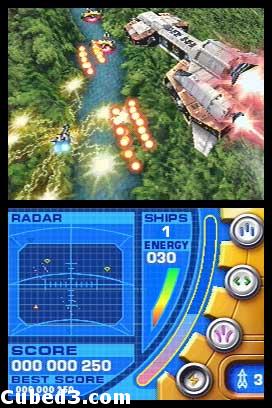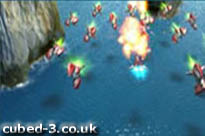Nanostray (Nintendo DS) Review
By Mike Mason  08.11.2005
08.11.2005
Many may know of Shin'En by their GBA titles, with the obvious one that will be most familiar with people being the shoot 'em up Iridion and its sequel. Having put their mark on Nintendo's handhelds since 1999, will the German developers be able to leave a lasting impression on the DS, too?
The shoot ‘em up is one of those ‘traditional’ genres of games that was popular back in the era when the arcade reigned supreme. Nowadays, their market is far more of a niche than before, but they still retain a lot of popularity with lots of people, many of whom enjoy a good challenge. The shoot ‘em up genre as a whole doesn’t let them down in this respect, and neither does Nanostray.
The game thrusts you straight into the action with no story gracing the book, case or cartridge; according to the website you are taking control of a man with amnesia (which he incurred during a blast to the side of his ship), but if you’re expecting this story to be examined anywhere in the game you can forget it (the bad pun police are on the way…). Instead, you’re simply set off on your eternally vertical journey through space and told to blast away to your heart’s content, destroying flying saucers that are presumably your enemies, as well as various robotic beasts, such as flying multi-segmented snake/dragon combos – they’re as nasty as they sound.

Pre-rendered backgrounds greet you as you switch on, helping to create a visual display that is certainly no letdown. By utilising this type of background it has been possible to make the DS display graphics that could be mistaken for Dreamcast quality on first glance – they are not, but they come pretty close to it and the screen resolution of the DS helps their case – not to mention that it runs at 60 frames per second. 3D is employed to powerful effect in the foreground to create imposing giant space-hubs that send squadrons of enemies out after you, and your ship and opponents are well done, even if their designs can be a little lacking in imagination at times (the bosses though, are often stunning). The weapon effects are beautiful too, but unfortunately when too much is going on on-screen there can be some slight slowdown. It’s clear that Shin’En have put a bucket load of effort into creating a gorgeous game which could probably be thrown into a puddle of mud and still come out sparkling.
Similarly keeping up the high quality presentation, the sound is a treat for the ears that may only be bettered on the DS by Osu! Tatekae! Ouendan, with a soundtrack that is distinctly sci-fi-ish techno filled to the brim with powerful bass; it fits the action to a tee. The DS’ slightly tinny speakers do not quite do the soundtrack justice, so it is best to play it through headphones; doing this scarily makes you really feel like you’re in the cockpit, with lasers zapping around you and enemies screeching about like they’re on acid. While the presentation is near flawless, however, there are both good and bad points about how the game actually plays…

It must be made clear that the gameplay is exceptional, but it is undeniably flawed. It is an unquestionably exhilarating experience, with the bass-heavy music pounding at your eardrums while wave after wave of enemy pour out at you, but what is questionable is how much better the game would’ve been if it took advantage of the DS’ unique hardware traits. Being a vertical shooter it might have been a given that it would be the first game of this type to take advantage of an extra large play area because of the vertically-stacked two screens, but sadly this is not the case. Instead, all the action is cramped up on to the top screen; in a bizarre twist, the game is possibly improved due to its uneconomical use of the dual screens, as everything is much more frantic as you scramble for life on the top screen.
The poor touch screen is relegated to be a kind of ‘control panel’ containing a radar, energy bars and weapon selections - presumably this is to make gamers feel more involved in their role as the pilot. We never used the radar because if a second was spared to look at it our faces were torn off by vicious space creatures – to say it’s a redundant feature is a bit of an understatement. The radar is replaced by boss information when you come to the end of the level – this is marginally more helpful. The energy bars aren’t offensive, but the weapon selection system will be to some people. Rather than mapping weapon switching to one of the face buttons somehow, you must press the buttons on the touch screen to choose which alien-melting implement of destruction you use. Admittedly, this is satisfying after a couple of levels of getting used to it, but with no hand free to use the stylus due to the main control being handled by the d-pad, face buttons and shoulder buttons, you are forced to reach over and treat them like extra face buttons, leaving thumbprints on the screen, and that gets the thumbs down. The arsenal at your fingertips is pleasing though, with four standard weapons (including a spiffing lightning gun that reassembles enemies into something we call ‘fire’ in just a few seconds) that can each be powered up for a limited time, as well as a few smart bombs that must be used sparingly.

While the main mode is quite short and may be completed relatively quickly (though the levels are all pretty difficult until they've been practiced a fair few times), Nanostray is immensely replayable. You can go back to try and best your scores and improve your techniques, but there are also Challenge and Arcade modes to stretch out the life of the game. Challenge mode proposes that the player complete specific missions while still trying to survive, while Arcade mode is a purely score based affair. Upon completion of an Arcade mode level, a code is generated which can be entered into the official website to rank you in online worldwide league tables, though sadly, as the game was finished well before the WiFi connection was sorted out, these must be entered manually on a PC. The two player mode is also quite fun, if a little limited; it might have been better to have a co-op mode that spanned the entire game, rather than being limited by points or time. Next time, eh?

Cubed3 Rating
Very Good - Bronze Award

With a little more development time, there’s no doubt that Shin’En could have turned this into one of the DS’ best games. As it stands, though, it is an above average game that could’ve been improved with better use of the DS’ features. With any luck a sequel is already well underway which takes advantage of the hardware better – make sure you throw in WiFi support for us next time, Shin’En!
Comments
Comments are currently disabled

 Sign In
Sign In Game Details
Game Details
 Q1 2005
Q1 2005  TBA
TBA  TBA
TBA  TBA
TBA  Subscribe to this topic
Subscribe to this topic Features
Features







 Top
Top

